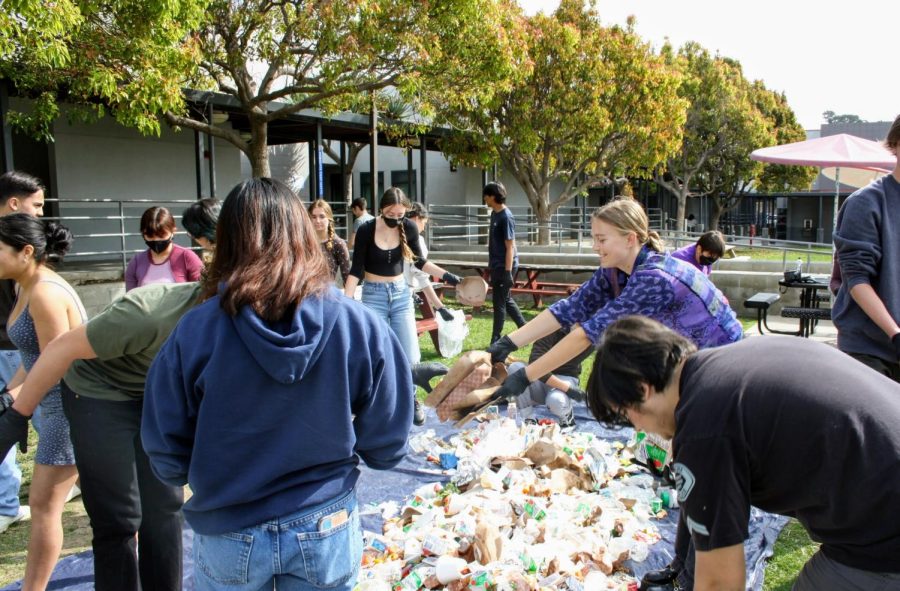Going green: The waste reduction project at Foothill Tech
Students diligently scoop up trash, gagging at the smell of the mountainous pile they are rummaging through.
April 16, 2022
It’s no secret that walking the halls of Foothill Technology High School (Foothill Tech) means encountering an unsettling amount of trash scattered around the walkways, especially after nutrition break and lunch. Not only does this attract seagulls to campus and inconvenience Foothill Tech’s janitors, but it also makes proper waste reduction and recycling all the more difficult.
On March 22, 2022, Foothill Tech’s Advanced Placement Environmental Science class heard from guest speaker Kelsey Hammond, an environmental specialist with the City of Ventura, about how to properly manage food waste both at home and on campus. Hammond explained that composting at home is the best solution for food waste because it reduces the need for transportation and its resulting emissions, supports the growth of gardens and above all else, lowers the environmental impact of processing organics. “If we throw food waste in the landfill, it breaks down anaerobically and produces a powerful greenhouse gas called methane,” said Hammond.

Hammond also elaborated on the process of doing a waste audit, or a survey of waste produced by an establishment, such as a school or a household. First, waste should be separated and collected for two to three days – food waste should be separated in a tied bag, liquids shouldn’t be disposed of in the trash, and each member of the facility should be involved to ensure a successful process.
After several days, the waste should be organized into categories, weighed and taken note of to see which products are being thrown away, what their purpose is and whether or not there are reusable solutions. The last step is simply to analyze the results, formulate a plan to reduce the most trash leaving the establishment and share the results with others to encourage waste reduction.
On March 31, 2022, Foothill Tech’s AP Environmental Science class did its very own waste audit on the lunchtime trash collected around the school, with goals of minimizing waste on campus and beginning the process of making Foothill Tech a Green School.
Emily Hunt, the AP Environmental Science teacher at Foothill Tech, described how the class separated waste from 8 trash cans “into food waste, recyclables, styrofoam, aluminum and trash.” Hunt explained that the waste audit “was very educational because we saw a lot of food waste specifically, and a lot of things that could have been recycled had they not been contaminated with food waste.”
Hunt also clarified that “A Green School is a school that is showing that they’re meeting particular federal goals for recycling, alternative transportation, elimination of food waste and having a nice, aesthetic environment for students.”
To help meet the goal of making Foothill Tech a Green School, the AP Environmental Science class as well as the Environmental Club are first focusing on “reducing food waste and recyclables, but there’s a lot more work to be done,” Hunt explained.
According to Hunt, by “not taking straws and packets of sporks if you’re not going to use them” and “putting [excess food] on the [cafeteria] table that can be donated to Food Share,” students can reduce the amount of trash leaving the school. “Hopefully we’ll have some more bins for students to discard food waste and recyclables, and educate students as to how to do that,” she finished.
Environmental programs at school can be important for the community as well. A major reason why there is so much trash is because most people, especially students, do not have the right tools to help properly manage their waste outflow. Programs that give students access to something as simple as a composting pile can easily reduce the waste in landfills.
Knowing the correct way to recycle can also help students lessen waste. For example, disposing of liquids in the recycling bin is harmful, since it can contaminate all of the recycling. According to Hammond, if this happened, “the recycling facility would not be able to recycle those items.” Education on correctly disposing of liquids and other types of contaminants is an easy way to reduce the amount of waste that goes to our landfills.
Environmental awareness is especially important in today’s age, as pollution and climate change become an increasing concern. Taking steps such as composting, recycling, using reusable products and doing waste audits are only some of the many things that students can do to protect the global landscape.
“If the community isn’t aware of our environmental issues, like our waste problem, people will not change their behavior,” Hammond concluded.

















Mrs. Hunt • Apr 21, 2022 at 1:50 pm
Fantastic Job! Thanks for helping spread awareness. I am so thrilled to see where the project is going to take us next!